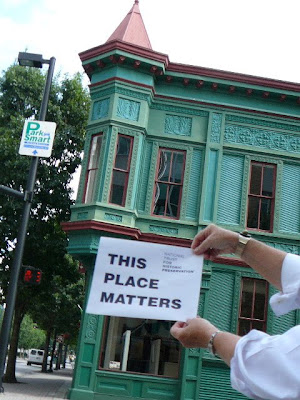
"Church Street Station represents the past, and Orlando cannot afford to live in it. St. Augustine and Savannah can but not our city." So concludes Mike Boslet, editor of Orlando Magazine. He continues: "So what can be done to Church Street Station? Simple: Encourage a developer to tear it down and build a modern, glass-encased, commercial low-rise on the site."
Stepping into the biggest preservation controversy Orlando has known, the abrupt distruction of the Jaymont block, Mr. Boslet says: "It’s not like the city hasn’t aided the demolition of an outdated piece of property before. The city expedited approval of Kuhn’s request to bulldoze the old Jaymont block in 2003. Mayor Buddy Dyer made that happen. Today a beautiful, albeit financially troubled, three-tower, commercial-residential condo development called The Plaza stands on Orange Avenue between Church and Pine streets. The old department store it replaced sat there for 60 years, the last two decades derelict. Does anyone really miss it?"
My answer is yes, I miss it. While the drug store that anchored the block (I forget if it was Woolworths or McCorys) had moved out, it was not derelict for 2 decades as he claimed. The Historic Preservationist for the city was working to preserve the building, but was blindsided by Orlando's mayor and the wrecking ball started swinging within minutes of the city council vote. In its place is a hollow condominium with few residents and bad art.
The premise of tearing down Church Street Station and the whole attitude of the editorial is prevalent in Central Florida. I often hear people complain about the lack of culture or history here, yet eagerly anticipate the arrival of any new chain store or franchise restaurant. I wrote the editor and urged others to do the same because the block occupied by Church Street Station, not only was home to one of Orlando's most successful attractions, it also has some of our oldest buildings.
The story goes that when Bob Snow, owner of Rosie O'Grady's in Pensacola, heard Disney was coming to Orlando, he came to Orlando looking for a site to build a "Rosies" here. He had little luck but on the way to the airport the cab driver drove him down Church Street and he found exactly what he was looking for. On the corner was the building formerly housing Slemons Department Store, built in 1926. Other vintage buildings included the Bumby Hardware Store, built by one of Orlando's pioneering families in 1884 and one of the oldest surviving commercial structures in town. Just across the railroad tracks is the historic train depot, which is on the the Historic Register.
I think it's unlikely that the attraction that was Church Street Station can ever exist again. But the buildings that housed "the home of Good Times" have more character and life left in them than any "glass glass-encased, commercial low-rise." Looming just beyond the Train Depot is a high rise condo known as 55 West. It is brand new and completely empty.
 129 W. Church St. originally Slemons Dept. Store, later Rosie O' Grady's, now vacant.
129 W. Church St. originally Slemons Dept. Store, later Rosie O' Grady's, now vacant. The heart of Church Street Station
The heart of Church Street Station "Built 1884, the Bumby Hardware is one of Orlando's earliest surviving commercial buildings."
"Built 1884, the Bumby Hardware is one of Orlando's earliest surviving commercial buildings." Old Railroad Depot, Built 1889. "...reflects the Late Victorian railroad architecture popular among New Englanders who funded the railway enterprise. The smooth undulating roof lines, eyebrow dormers, circular tower and bulbous column of the 2nd floor relate to the style developed by architect HH Richardson of Boston..."
Old Railroad Depot, Built 1889. "...reflects the Late Victorian railroad architecture popular among New Englanders who funded the railway enterprise. The smooth undulating roof lines, eyebrow dormers, circular tower and bulbous column of the 2nd floor relate to the style developed by architect HH Richardson of Boston..." My anger at this point of view expressed in the editorial, led me to the National Trust for Historic Preservation's website where I found and participated in the "This Place Matters" campaign. Here are some of the places that matter most to me.
 The Rogers Building, built 1884 . Originally was the English Club for English settlers in the Conway area. Currently an art gallery. On the Historic Register.
The Rogers Building, built 1884 . Originally was the English Club for English settlers in the Conway area. Currently an art gallery. On the Historic Register. The Orange County Regional History Center, built 1927. Originally the the Orange County Courthouse, designed by architect Murry S. King, Florida's first licensed architect. On the Historic Register.
The Orange County Regional History Center, built 1927. Originally the the Orange County Courthouse, designed by architect Murry S. King, Florida's first licensed architect. On the Historic Register. Orlando Public Library built 1966. The Brutalist style building is often criticized by residents for its stark appearance. Expansion in the 1980s was handled by Nils Schweizer, protege of Frank Lloyd Wright.
Orlando Public Library built 1966. The Brutalist style building is often criticized by residents for its stark appearance. Expansion in the 1980s was handled by Nils Schweizer, protege of Frank Lloyd Wright.



No comments:
Post a Comment